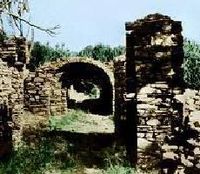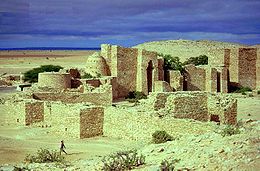- Dervish state
-
Dervish State
Daraawiish
دولة الدراويش1896–1920 Flag
Capital Taleex Language(s) Somali, Arabic Religion  Islam
IslamGovernment Monarchy History - Established 1896 - Disestablished 1920 The Dervish state (Somali: Daraawiish, Arabic: دولة الدراويش) was an early 20th century Somali Sunni Muslim state that was established by Muhammad Abdullah Hassan, a religious leader who gathered Somali soldiers from across the Horn of Africa and united them into a loyal army known as the Dervishes. This Dervish army enabled Hassan to carve out a powerful state through conquest of lands claimed by the Somali Sultans, the Ethiopians and the European powers. The Dervish State acquired renown in the Islamic and Western worlds due to its resistance against the European empires of Britain and Italy. The Dervish forces successfully repulsed the British Empire in four military expeditions, and forced it to retreat to the coastal region.[1] As a result of its fame in the Middle East and Europe, the Dervish State was recognized as an ally by the Ottoman Empire and the German Empire.[2][3] It also succeeded at outliving the Scramble for Africa, and remained throughout World War I the only independent Muslim power on the continent. After a quarter of a century of holding the British at bay, the Dervishes were finally defeated in 1920, when Britain for the first time in Africa used aeroplanes to bomb the Dervish capital of Taleex.
Contents
Origins
History of Somalia 
Ancient Laas Geel Culture Kingdom of Punt Malaoites · Oponeans Mosyllonians Medieval Kingdom of Ifat Warsangali Sultanate Adal Sultanate Ajuuraan Empire Early modern Gobroon Dynasty Majeerteen Sultanate Modern Sultanate of Hobyo Dervish State Italian Somaliland British Somaliland Independence Aden Adde Administration Shermarke Administration Communist rule Recent History Somali maritime history At the end of the 19th century, the Berlin conference gathered together Europe's most powerful countries who decided amongst themselves the fate of the African continent. The British, Italians and Ethiopians partitioned Greater Somalia into spheres of influence, cutting into the previous nomadic grazing system and Somali civilizational network that connected port cities with those of the interior. The Ethiopian Emperor Menelik's Somali expedition, consisting of an army of 11,000 men, made a deep push into the vicinity of Luuq in Somalia. However, his troops were soundly defeated by the Gobroon army, with only 200 soldiers returning alive. The Ethiopians subsequently refrained from further expeditions into the interior of Somalia, but continued to oppress the people in the Ogaden by plundering the nomads of their livestock numbering in the hundreds of thousands. The British blockade in firearms to the Somalis rendered the nomads in the Ogaden helpless against the armies of Menelik. With the establishment of important Muslim orders headed by Somali scholars such as Shaykh Abd Al-Rahman bin Ahmad al-Zayla'i and Uways al-Barawi, a rebirth of Islam in East Africa was soon afoot. The resistance against the colonization of Muslim lands in Africa and Asia by the Afghans and Mahdists would inspire a large resistance movement in Somalia. Muhammad Abdullah Hassan, a former nomad boy that had travelled to many Muslim centers in the Islamic world, returned to Somalia as a grown man and began promoting the Salihiya order in the urban cities and the interior where he found major success.
In 1897, Hassan left Berbera. On this journey, at a place called Daymoole, he met some Somali children who were being looked after by a Catholic Mission. When he asked them about their clan and parents, the Somali orphans replied that they belonged to the "clan of the (Catholic) Fathers." This reply shook his conscience, for he felt that the "Christian overlordship in his country was tantamount to the destruction of his people's faith." In 1899, some soldiers of the British armed forces met Hassan and sold him an official gun. When questioned about the loss of the gun, they told their superiors that Hassan had stolen the gun from them. On 29 March 1899, the British Vice Consul wrote a very stern and insulting letter to him asking him to return the gun immediately, which someone in Hassan's camp had reported stolen. This enraged Hassan and he sent a very brief and curt reply refuting the allegation. While Hassan had really been against the Ethiopian invaders of Somalia, this small incident caused a clash with the British.[4]
Capital
The Sayyid during his campaigns against the European and local powers built fortresses all over the Horn of Africa, and would move his armies from one city to another. In 1913, after the British withdrawal to the coast, the permanent capital and headquarters of the Dervishes was constructed at Taleh, a large walled town with fourteen fortresses. The main fortress, Silsilat, included a walled garden and a guard house. It became the residence of Muhammad Abdullah Hassan, his wives, family, prominent Somali military leaders, and also hosted several Turkish, Yemeni and German dignitaries, architects, masons and arms manufacturers. A large area to the northeast of Taleh was used for cultivation, while the Dar Ilalo towers were used as granaries. Several tombs were constructed by Muhammad Abdullah Hassan to honor his father, mother and prominent members from northern and southern Somalia. However, those that committed acts of treason, crimes or who had otherwise fallen out with the Dervish leader were sent to Hed Kaldig, the main execution arena.[5]
Economy
The Dervish domination of the hinterland in the Somali peninsula brought important trade routes under their hegemony, which they exploited by redirecting the wealthy livestock trade to port cities such as Las Khorey, Eyl and Ilig. Important imports included firearms, horses and building material for the construction of several dozen fortresses in the Horn of Africa.
Military
The regular army (Maara-weyn) of the Dervish state was organised into seven regiments: Shiikh-yaale, Gola-weyne, Taar-gooye, Indha-badan, Miinanle, Dharbash and Rag-xun. Each regiment had its commander (muqaddim) and varied from between 1000 to 4000 men. A large para-military force was also drawn from the nomad population. Bodyguards (Gaarhaye) of Muhammad Abdullah Hassan and other senior members of the state were either freed slaves whom he had adopted as sons or riverine groups such as the Reer Baarre. The cavalry, for its part, numbered between 5000 and 10000 mounted horsemen, and the standing army was supplied with modern weapons such as rifles and maxim guns.
Wars against Italy, Britain and Ethiopia
See also: 1920 conflict between British forces and the Dervish State
In August 1898, the Dervish army occupied Burao, an important centre of British Somaliland, giving Muhammad Abdullah Hassan control over the city's watering places. Hassan also succeeded in making peace between the local clans and initiated a large assembly, where the population was urged to join the war against the invaders.
In 1900, an Ethiopian expedition which had been sent to arrest or kill Hassan looted a large number of camels. Hassan in return attacked the Ethiopian garrison at Jijiga on 4 March of that year and successfully recovered all the looted animals. He gained great prestige in recovering the looted stock from the Ethiopians and he used it along with his charisma and powers of oratory to improve his undisputed authority on the Ogaden. To harness Ogaden enthusiasm into final commitment, Hassan married the daughter of a prominent leader and in return gave his own sister, Toohyar Sheikh Adbile, to Abdi Mohammed Waale, a notable elder.
Towards the end of 1900, the Ethiopian Emperor Menelik II proposed a joint action with the British against the Dervish. Accordingly, British Lt. Col. E.J. Swayne assembled a force of 1,500 Somali soldiers led by 21 European officers and started from Burco on 22 May 1901, while an Ethiopian army of 15,000 soldiers started from Harar to join the British forces intent on crushing the 20,000 Dervish fighters (of whom 40 percent were cavalry).
Modern legacy
The Dervish legacy in Somalia can be seen in the country's cultural heritage, history, and society. In memory of past heroes, the military government of Somalia led by Mohamed Siad Barre erected statues visible between Makka Al Mukarama and Shabelle Roads in the heart of Mogadishu. These were for three major Somali History icons; Muhammad Abdullah Hassan, Stone Thrower and Hawo Tako. Other historical facts about Somalia, numerous castles and fortresses built by the Dervishes were included in a list of Somalia's national treasures.[6] The Dervish period spawned many war poets and peace poets involved in a struggle known as the Literary war which had a profound effect on Somali poetry and Literature, with Muhammad Abdullah Hassan featuring as the most prominent poet of that Age.[7] Many of these poems continue to be taught in Somali schools and have been recited by several Presidents of Somalia in speeches as well as in poetry competitions. In Somali Studies, the Dervish period is an important chapter in Somalia's history and its brief period of European hegemony, the latter of which inspired the resistance movement. Due to their goal of creating a unified Somali State or Greater Somalia transcending regional and clan divisions, many scholars regard the Dervishes as the ideological architects of Somalia[8] and Muhammad Abdullah Hassan himself as the "Father of the Nation".[9]
In popular culture
- The documentary film The Parching Winds of Somalia includes a section on the Dervish struggle and its leader Muhammad Abdullah Hassan.
- The historic romance novel Ignorance is the Enemy of Love by Farah Mohamed Jama Awl has a Dervish protagonist called Calimaax, who is part of an ill-fated love story and fights against the British, Italians and Ethiopians in the Horn of Africa.
- A 1983, film entitled A Somali Dervish was directed by Abdulkadir Ahmed Said.
- In the Law & Order: Criminal Intent episode Loyalty, references are made to the Dervishes and their leader. The episode also features a character purported to have been descended from Muhammad Abdullah Hassan.
- In 1985, a 4 hour and 40 minute Indian-produced epic film by filmmaker Salah Ahmed entitled the Somalia Dervishes went into production. With a budget of $1.8 million, it included an actual descendant of Hassan as its star, and featured hundreds of actors and extras.[10]
- In the popular comic book series Corto Maltese, the protagonist travels to the Horn of Africa during the Dervishes' battle against the British, and witnesses the former power storm a British fort. During these travels, he develops a long-term friendship with a Dervish warrior named Cush, who subsequently features in several other of Corto's adventures around the world.
See also
- History of Somalia
- Muhammad Abdullah Hassan
- Hasna Doreh
References
- ^ Encyclopedia of African history – Page 1406
- ^ The modern history of Somaliland: from nation to state – Page 78
- ^ Historical dictionary of Ethiopia – Page 405
- ^ The Failure of The Daraawiish State: The Clash Between Somali Clanship and State System Abdisalam M. Issa-Salwe – the 5th International Congress of Somali Studies December 1993
- ^ Taleh W. A. MacFadyen The Geographical Journal, Vol. 78, No. 2 (Aug., 1931), pp. 125–128
- ^ Beautiful Somalia – Page 86
- ^ SOMALIA: A Nation's Literary Death Tops Its Political Demise by Said S Samatar
- ^ Pg 393 – Literatures in African Languages: Theoretical Issues and Sample Surveys By B. W. Andrzejewski, S. Pilaszewicz, W. Tyloch
- ^ Pg 187 – The Soviet Union in the Horn of Africa: the diplomacy of intervention and Disengagement By Robert G. Patman
- ^ Exploits of Somalia's national hero becomes basis for movie – Kentucky New Era
Categories:- Former countries in Africa
- States and territories established in 1896
- States and territories disestablished in 1920
- 1920 disestablishments
- Somali empires
Wikimedia Foundation. 2010.






